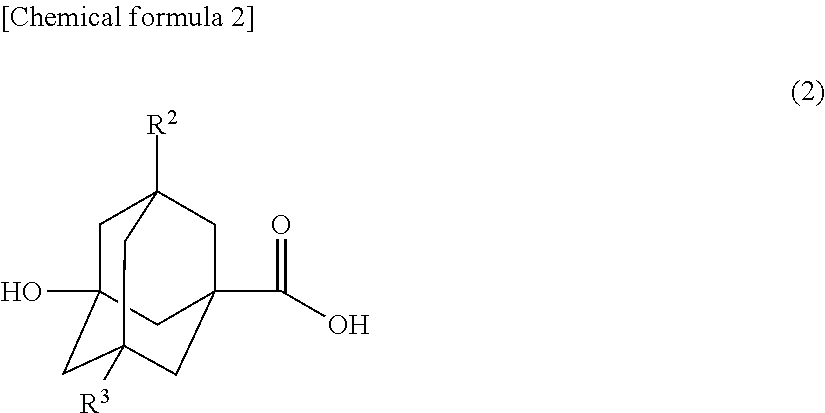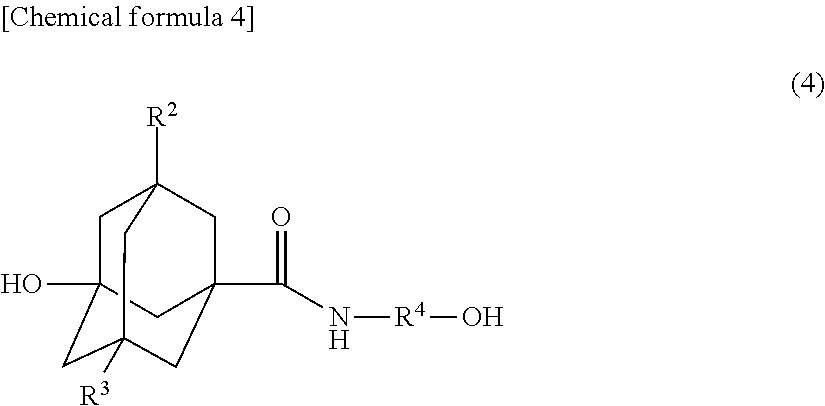Method for producing novel ali cyclic ester compound, novel alicyclic ester compound, (METH)acrylic copolymer produced by polymerizing said compound, and photosensitive resin composition using said copolymer
a technology of alicyclic ester and compound, which is applied in the direction of photomechanical equipment, instruments, organic chemistry, etc., can solve the problems of single repeat unit resin, influence of contrast deterioration caused by diffusion of acid, and the use of functional resins, etc., to achieve the effect of improving resolution and line edge roughness
- Summary
- Abstract
- Description
- Claims
- Application Information
AI Technical Summary
Benefits of technology
Problems solved by technology
Method used
Image
Examples
example 1
Production of 3-hydroxy-N-(2-hydroxyethyl)adamantane-1-carboxamide
[0083]
[0084]A 100 ml three-necked round bottom flask provided with a stirrer, a thermometer, and a distillation cooling device was supplied with 9.81 g (0.05 mol) of 3-hydroxyadamantane-1-carboxylic acid and 15.27 g (0.25 mol) of ethanolamine, and was heated to 150° C. The temperature was raised from 150° C. to 180° C. over 5 hours. During this time period, generated water was removed by distillation together with ethanolamine. After the reaction was finished, the resultant viscous liquid was dissolved in ethyl acetate, and the resultant solution was provided to fill a silica gel column. A top part of the solution was removed with ethyl acetate, and then the remaining part was fractionated and purified with a developing solvent, which was ethyl acetate / methanol═50 / 1 (v / v). The solvent was removed by distillation at reduced pressure. As a result, 6.13 g of 3-hydroxy-N-(2-hydroxyethyl)adamantane-1-carboxamide was obtain...
example 2
RESIN SYNTHESIS EXAMPLE 1
[0091]3.08 g of 2-(3-hydroxyadamantane-1-carboxamide)ethylmethacrylate (hereinafter, referred to as “monomer A1”) obtained in Example 1, 4.97 g of 2-ethyl-2-methacryloyloxyadamantane (hereinafter, referred to as “monomer B1”), 3.39 g of α-methacryloyloxy-γ-butyrolactone (hereinafter, referred to as “monomer C1”), and 0.41 g of azobisisobutyronitrile were dissolved in 120 mL of tetrahydrofuran, and polymerization was performed for 15 hours while the reaction temperature was kept at 60° C. in a nitrogen atmosphere (the ratio of monomer amounts was A1 / B1 / C1 =20 / 40 / 40 mol %). After the polymerization, the reaction solution was dripped into 600 mL of n-hexane to solidify and purify the resin. The generated white powder was filtrated by a membrane filter and washed with 1000 ml of n-hexane. The white powder was recovered, and dried overnight at 40° C. at reduced pressure. As a result, 8.12 g of methacrylic copolymer P1 was obtained.
example 3
RESIN SYNTHESIS EXAMPLE 2
[0092]3.07 g of 2-(3-hydroxyadamantane-1-carboxamide)ethylmethacrylate (hereinafter, referred to as “monomer A1”) obtained in Example 1, 5.25 g of 2-adamantyl-2-methacryloyloxypropane (hereinafter, referred to as “monomer B2”), 4.45 g of 2-methacryloyloxy-5-oxo-4-oxatricyclo[4.2.1.03,7]nonane (hereinafter, referred to as “monomer C2”), and 0.41 g of azobisisobutyronitrile were dissolved in 120 mL of tetrahydrofuran, and polymerization was performed for 15 hours while the reaction temperature was kept at 60° C. in a nitrogen atmosphere (the ratio of monomer amounts was A1 / B2 / C2═20 / 40 / 40 mol %). After the polymerization, the reaction solution was dripped into 600 mL of n-hexane to solidify and purify the resin. The generated white powder was filtrated by a membrane filter and washed with 1000 ml of n-hexane. The white powder was recovered, and dried overnight at 40° C. at reduced pressure. As a result, 7.75 g of methacrylic copolymer P2 was obtained.
PUM
| Property | Measurement | Unit |
|---|---|---|
| photosensitive | aaaaa | aaaaa |
| heat resistance | aaaaa | aaaaa |
| chemical resistance | aaaaa | aaaaa |
Abstract
Description
Claims
Application Information
 Login to View More
Login to View More - R&D
- Intellectual Property
- Life Sciences
- Materials
- Tech Scout
- Unparalleled Data Quality
- Higher Quality Content
- 60% Fewer Hallucinations
Browse by: Latest US Patents, China's latest patents, Technical Efficacy Thesaurus, Application Domain, Technology Topic, Popular Technical Reports.
© 2025 PatSnap. All rights reserved.Legal|Privacy policy|Modern Slavery Act Transparency Statement|Sitemap|About US| Contact US: help@patsnap.com



